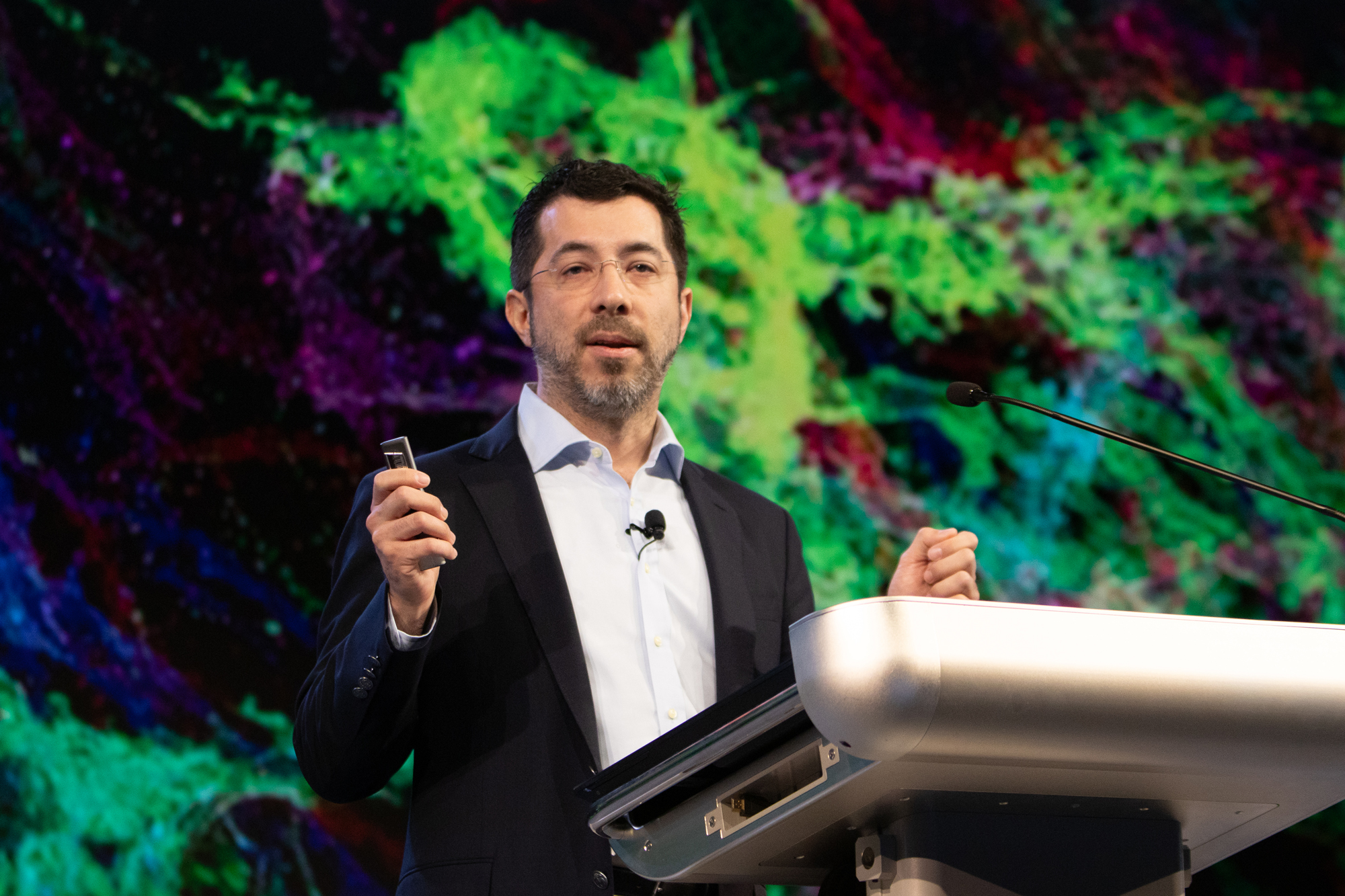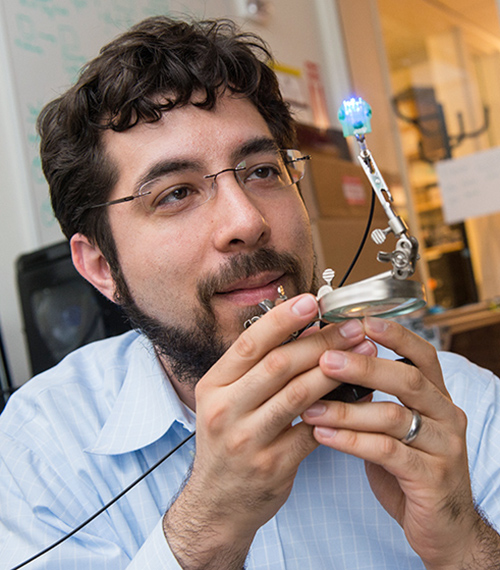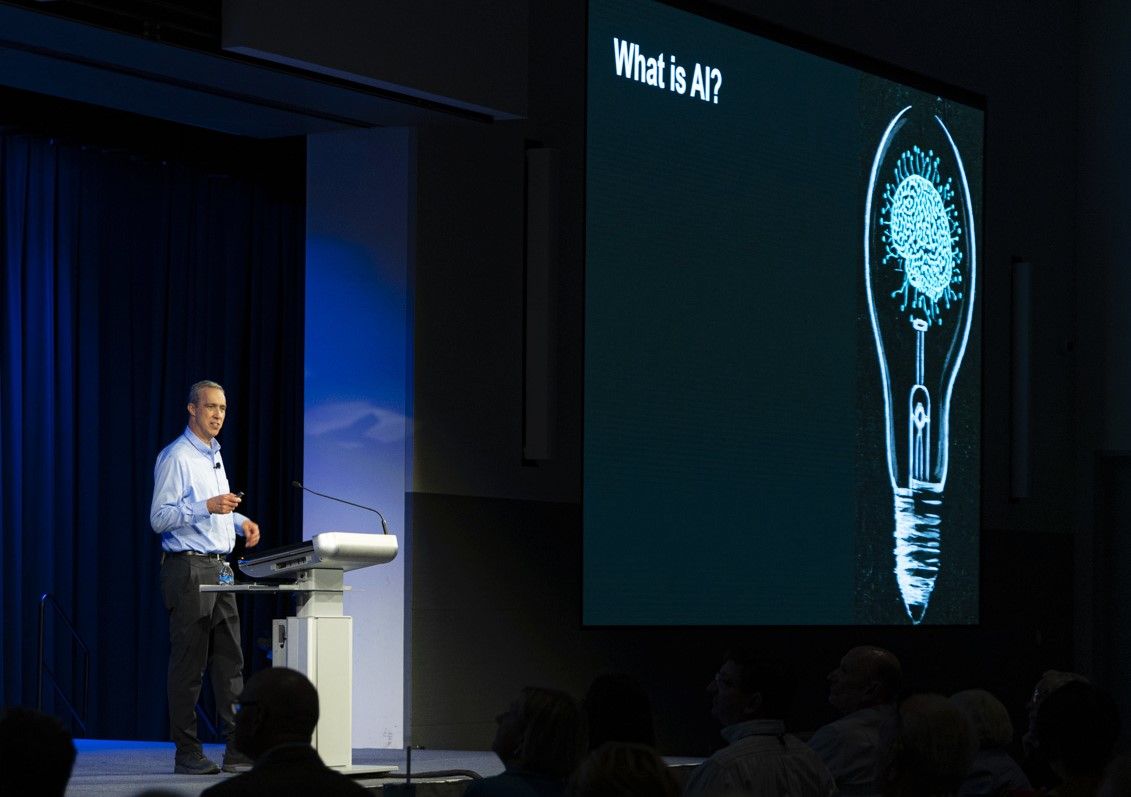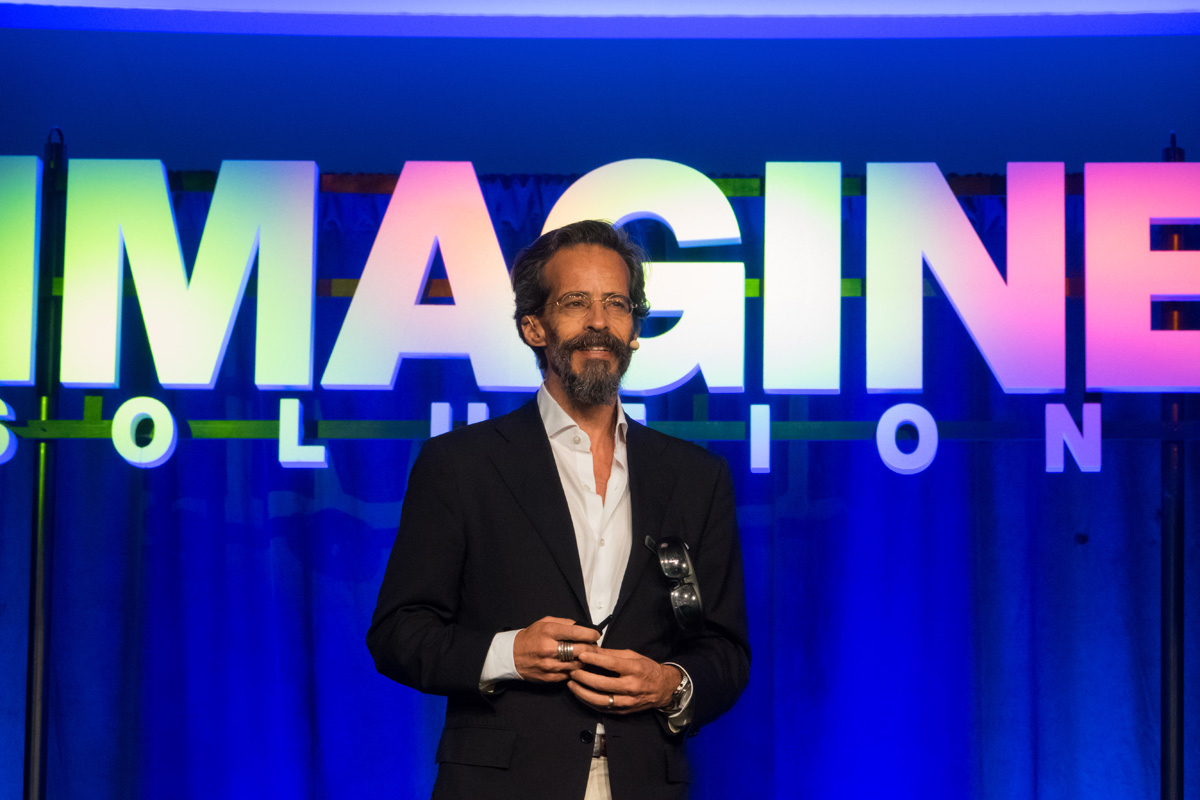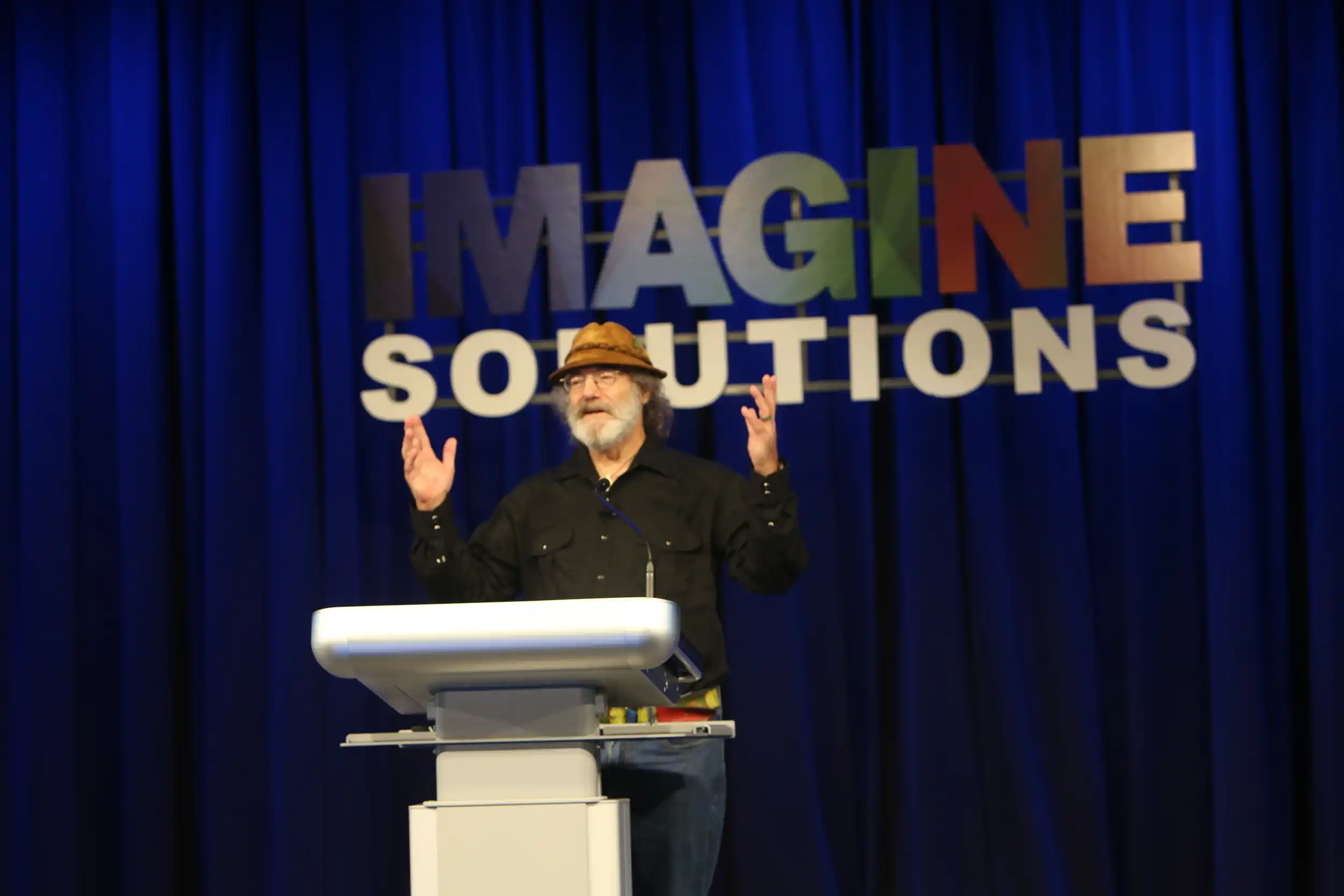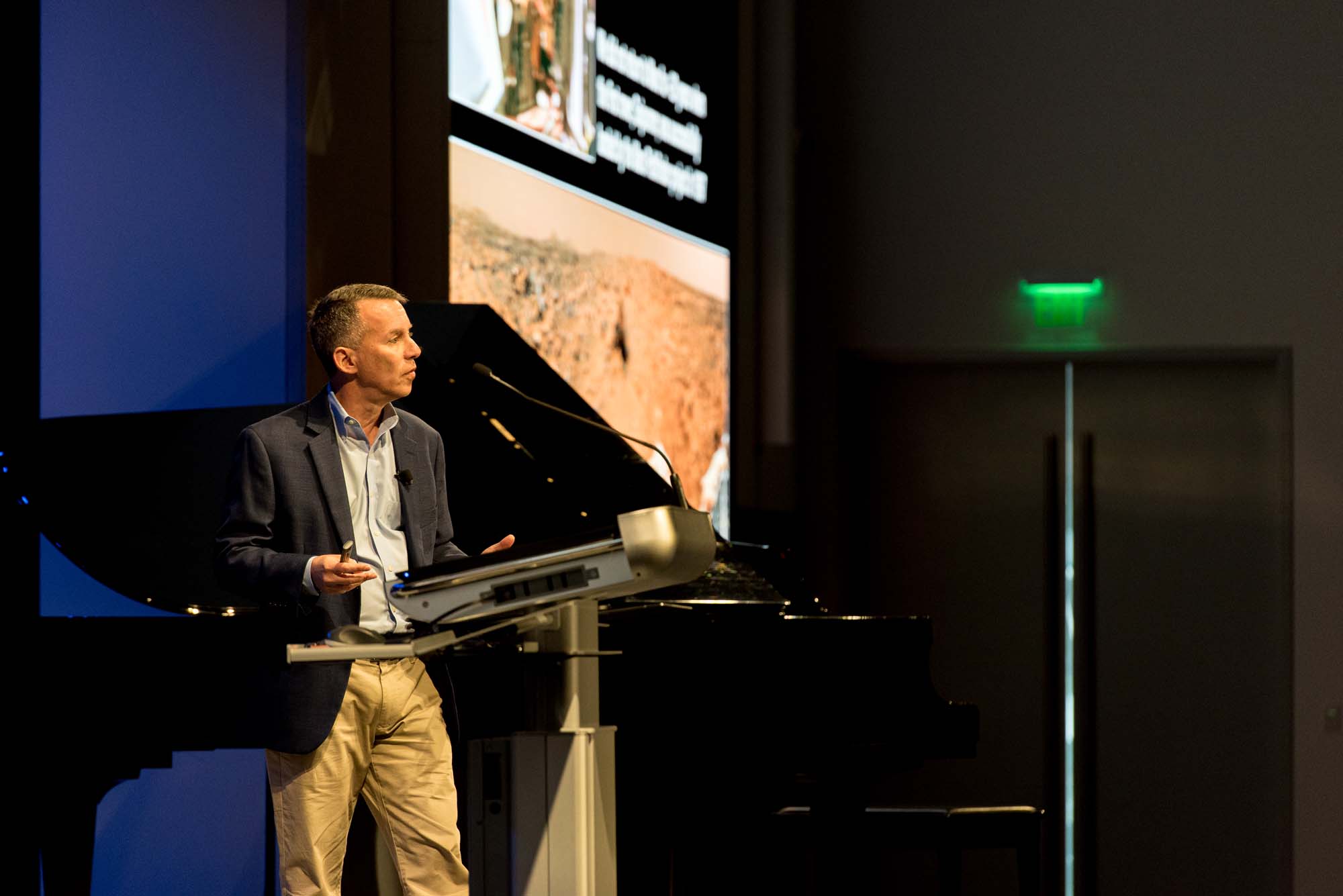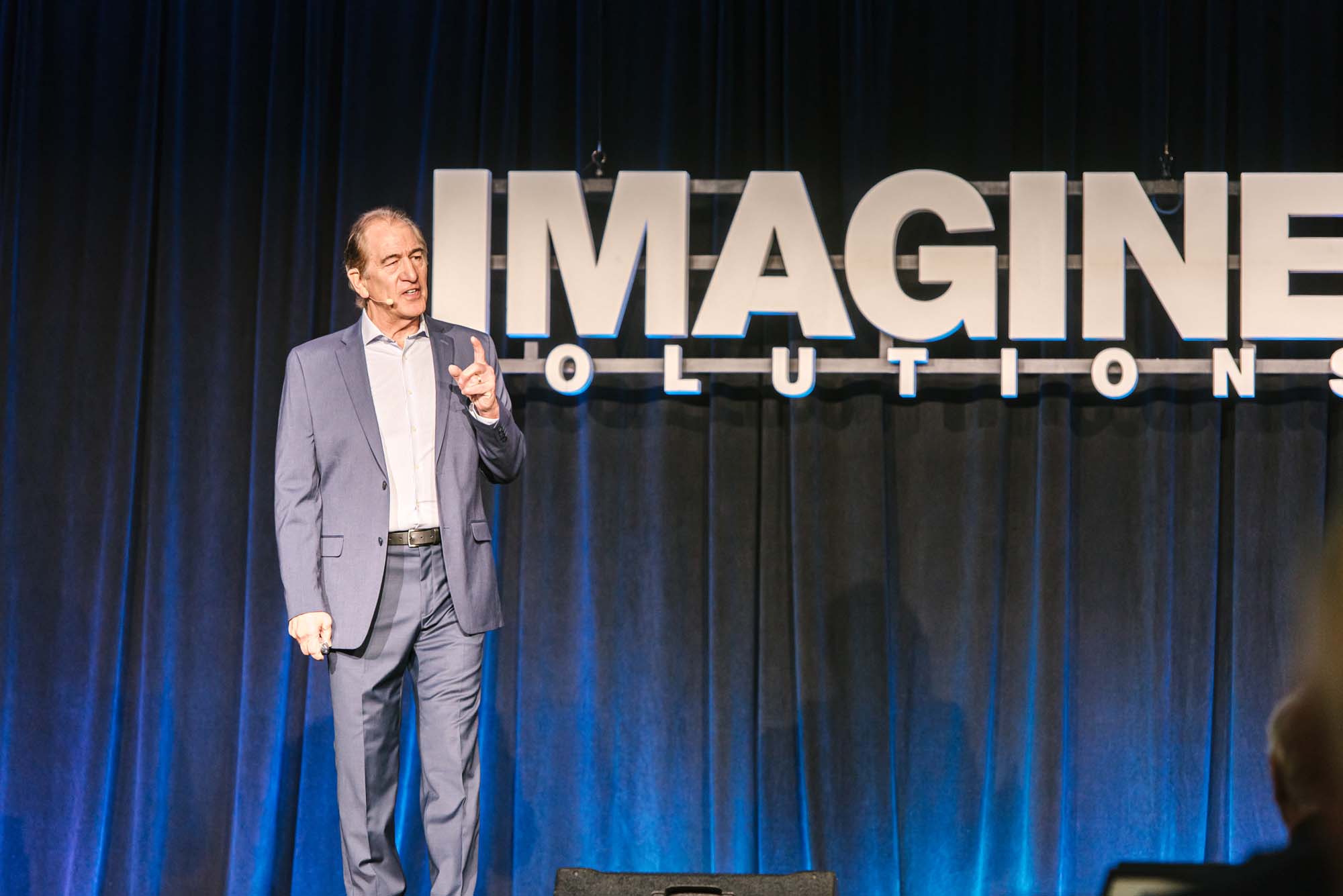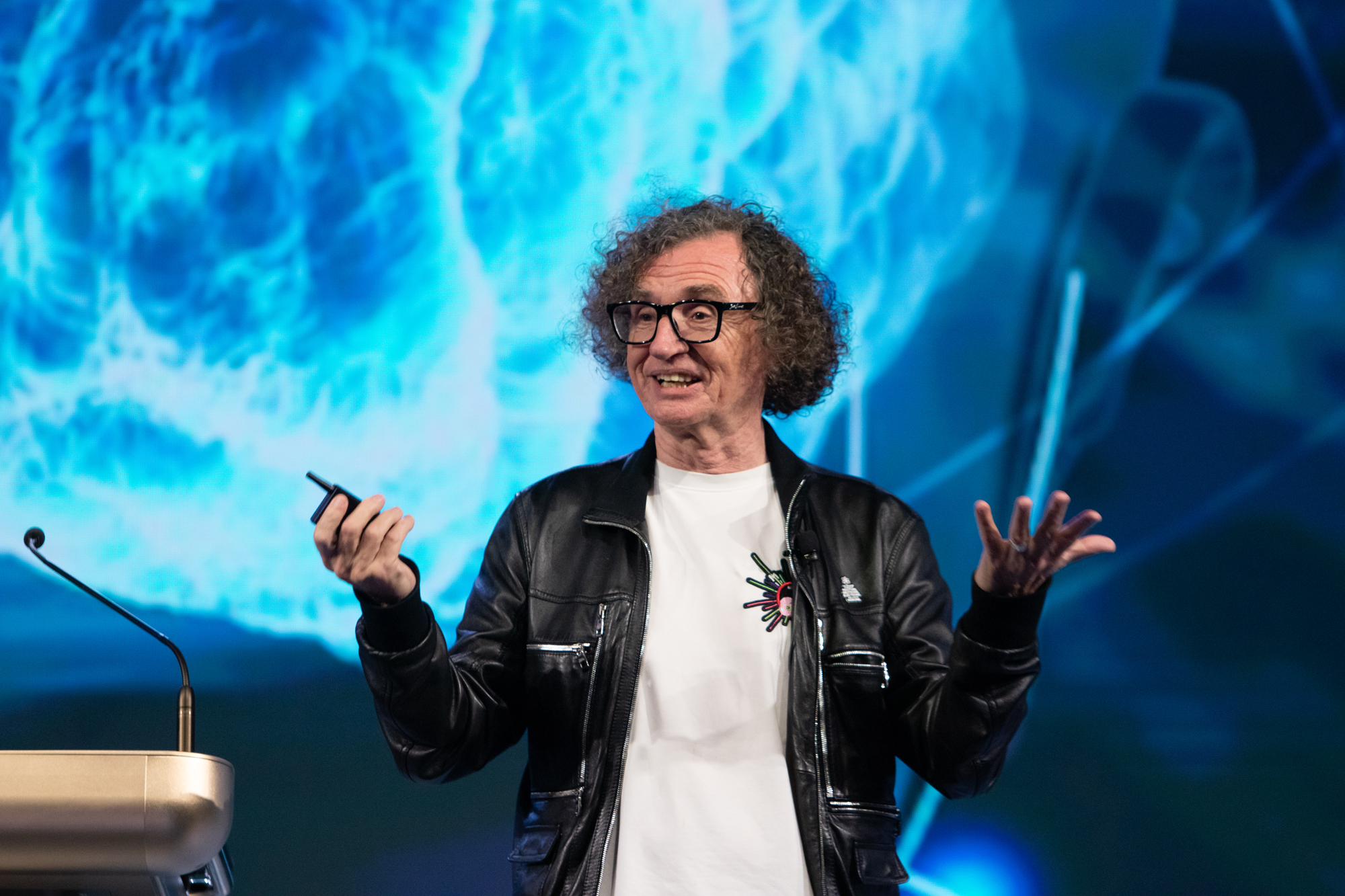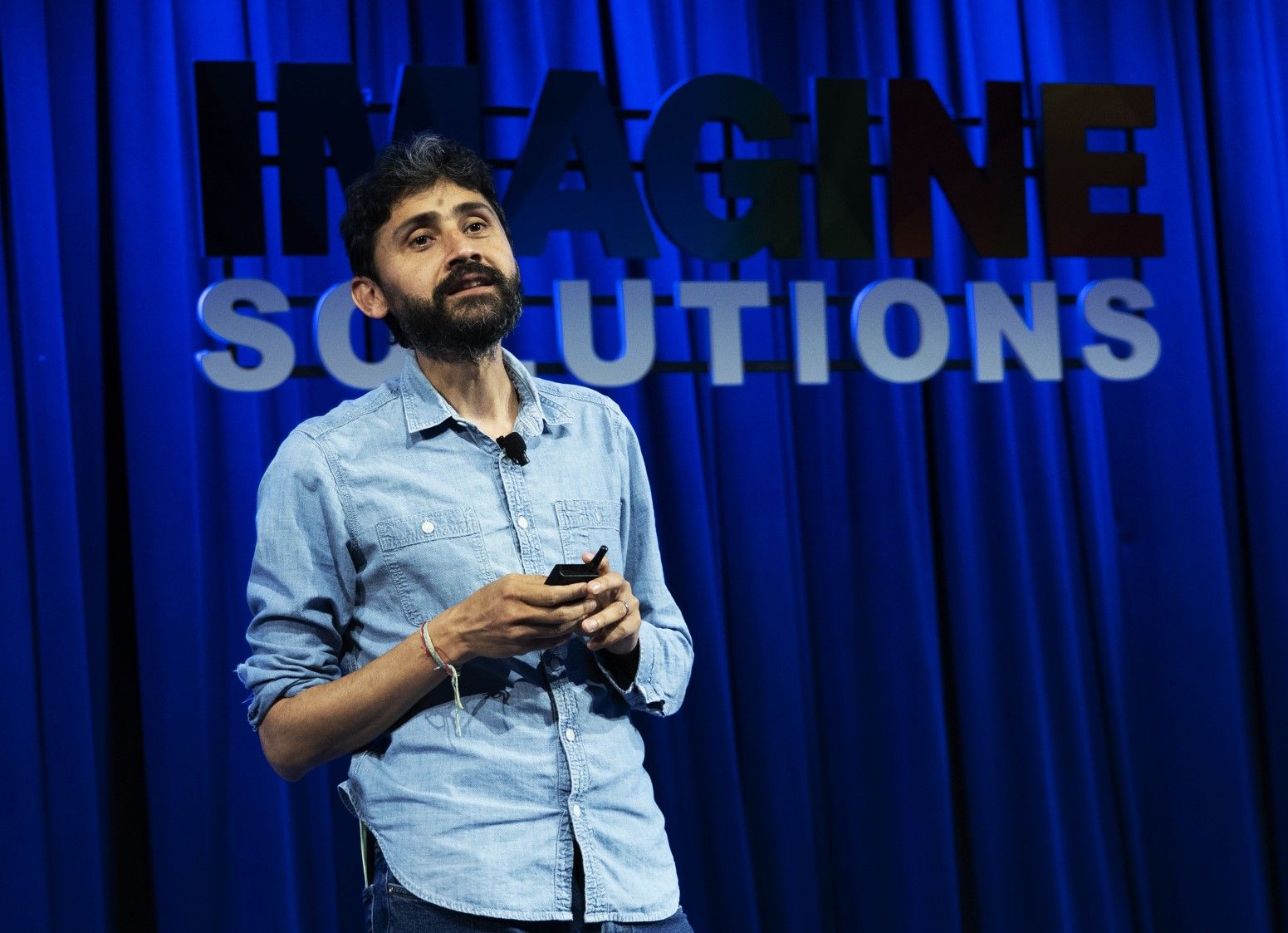A Genius Neuroscientist
MIT’s Ed Boyden delivered a mind-blowing look at the tools revolutionizing brain science. A pioneer in neurotechnology, Boyden explained how innovations like optogenetics and expansion microscopy are enabling scientists to map and manipulate the brain with unprecedented precision. His talk bridged science fiction and reality, showing how these breakthroughs could lead to new treatments for mental illness, neurodegenerative disorders, and more. Audiences left with a sense of awe at the complexity of the brain—and the promise of technologies now unlocking its secrets.
00.00
[Music] our next speaker is often referred to by his colleagues as a neuroscience genius ed Bdon won the mathematics category at the Texas State Science Context contest excuse me at age 12 at age 16 he entered MIT after skipping two grades he graduated at 19 boy his his career trajectory is just like mine i'm telling you this is exactly right at 19 he graduated with one master's degree and two bachelor of science degrees one in physics the other in computer science he received his PhD in neuroscience six in six years became a tenure professor at MIT in seven and today he directs three different programs at MIT ed Bdon has developed four different technologies that could someday win a Nobel Prize to
01.00
go along with the many other prizes that he has won already he understands the brain and how it functions as few people in the world do ladies and gentlemen Ed Boydon growing up just north of Dallas Texas I was really mystified by just existence as a child you know why do we do what we do feel what we feel think what we think uh and why can we be cruel to each other why do we make bad decisions you know why is humanity the way it is can we become better and over the years I explored different parts of engineering of science and honed in on this idea that maybe we should really try to build technology to help us understand ourselves through understanding the brain our brains in our heads are incredibly complicated objects so in a cubic millimeter of our brain could be 100,000 tiny brain cells
02.03
called neurons and they're wired up with these elaborate treelike patterns that allow them to connect up like a computer circuit but far more intricate and elaborate than one can possibly imagine the brain cells in our heads fire off little electrical pulses and they communicate right now as I say these words auditory parts of your brain visual parts of your brain they're all registering millisecond time scale electrical pulses how can we understand this and how it generates our dreams and our thoughts and our feelings but there's another reason why this quest is important beyond mere curiosity beyond the hope that we could understand our philosophy our existence and our beings and that is brain diseases disorders and conditions that affect people all over the
03.01
world and look at the list alzheimer's disease spinal cord injury stroke these diseases do not have a cure and the treatments are quite partial and have a lot of side effects these diseases can affect us not only in terms of our time to live but they can change who we are so how can we tackle this problem well the complexity of the brain is very daunting it's this densely packed machine and so the prospects so far have been slow and difficult these are some numbers from an edi uh an editorial in Science magazine from a bit over a decade ago and I think that the numbers have in some ways gotten even worse but a clinical trial for a brain drug might take you a decade the failure rate will be distressingly close to 100% the cost will be enormous i think it's now several billion each and even
04.02
if you make it through those hurdles even if your therapy is approved there's a good chance that it only works partly and that it has side effects for a significant fraction of the people so what can you do about it well the history of science shows us that when a scientific field hits the ground truth the fundamental understanding the list of those building blocks and how they work together for example then you can make progress in an accelerated way let's look at physics for example quantum mechanics a century ago allowed us to understand the parts particles and how they work together forces and in the centuries since we had the transistor and the laser and the microchip and the internet and so forth an exponentially growing body of scientific enterprise that had huge impact on everyday life what's the ground truth for the brain well the brain is extremely complicated let's zoom in a little bit
05.02
so the spatial scale of the brain is challenging right the brain is an enormous object and yet the wiring of the brain is nanocale we're talking about much smaller than the diameter of a human hair so how do you cross those scales from the tiny to the large that's a challenge for science that demands new technology and then there's temporal scales so over the time scale of aging or the development of a disease like Alzheimer's or the learning of a language these are slow processes that can take years but the briefest elements in the brain are these millisecond time scale electrical pulses within brain cells and the chemical exchanges that happen within them so I lead a group at MIT where we build tools to try to help brain scientists conquer the spatial and temporal dimensions to understand the brain ideally we would be able to control those high-speed electrical signals we can understand what they do and maybe
06.01
repair brain states that need help we should watch what's going on in the brain so we can understand what information is there and ideally we would map out the wiring of the brain so we know how it's architected how the structure is organized now that's a lot of data how can we understand it i would like to argue that one of the best ways of integrating all that data would be to make a computer simulation of the brain we could integrate these tools which I'll talk about in a second control recording and mapping and derive data sets that could allow us to recapitulate the brain in software why would this be useful well as I mentioned just now one issue of course is just the sheer complexity of all that we would have to unveil but a computer simulation could be used to try to pinpoint where in the brain to optimally intervene causality is hard but if you can screen in software or in a computer you could go at high throughput maybe we would be able to
07.00
watch what happens as a thought takes shape or an emotion happens and see maybe maybe even someday what a subjective experience might look like and of course AI is all the rage right now but I think it's very clear that making humanlike AI could be very important if we want to recapitulate things like human like ethics and judgment and one way to achieve that might be to study the brain at a level of detail that will let you recapitulate it so today I will tell you a couple short stories about these tools and how they work and what we can do with them let's start with control brain cells use electrical pulses to compute how do we control them well suppose you could put little solar panels in them and then shine light on them light gets converted to electricity and you could then aim the light wherever you want and the brain doesn't feel pains you could bring optical fibers into the brain the same way that electrodes are brought into the brains of awake human patients for deep brain stimulation now how do we make brain cells have little solar panels well it
08.01
turns out all over the tree of life you can find molecules that convert light into electrical energy or electrical signals here we have a single cell microbe a green algae and it's swimming around in a body of water and the way that it knows where the sun is is that has an ice spot which we just zoomed into and that ice spot is chalk full of proteins that convert light into electrical signals when they're hit by light from the sun they open up a little pore and let charged particles across that's exactly what you'd want right if you wanted to make electrical signals in response to light what happened next was a bit of serendipity we decided to take the gene that encodes for this protein and put it into the brain this might have failed right maybe the gene product would have been toxic or maybe it would have been too slow or ineffective but serendipity is a big driver of science and curiosity feeds that serendipity and we were very very lucky we took the gene that encoded for
09.01
this light activated protein and put it into the brain using a gene therapy vector and now the brain cell could manufacture this gene product or protein and miraculously it was able to install that protein on the boundary or membrane of that neuron which is where the electrical activities are generated and even more serendipitously perhaps it worked we could shine light from a laser or an LED onto this brain cell and it would then generate electrical pulses not unlike the ones right now happening in your brains as you hear me say these words now this movie has some flashing images so if somebody's photosensitive um maybe uh you don't watch this until I get back to you but I want to illustrate how the technology uh works so brains of course have many kinds of cells and we can use tricks of gene therapy to put the light activated protein into some cells and not others then uh the gene therapy vector will deliver the gene the brain cells
10.00
the neurons will manufacture the proteins and install them and those cells will become light sensitive and not their neighbors we can then aim light from an LED or a laser at the brain and the cells that we have transduced will respond to light but their neighbors will not that's how we can control the brain very precisely okay the flashing images are over if that's of importance okay let's give some examples of how this works in action i'll start by talking about dopamine neurons in the popular press people often talk about them as the pleasure center of the brain but of course brain science is very complex so in this study investigators took our light activated uh protein that I just mentioned and used a gene therapy vector to make the brain cells of mice that have dopamine respond to light what does activating these cells do well if it drives reward you might imagine that if a mouse were to go poke its nose into a sensor and get a pulse of light it
11.00
would want to go to that place more often and if there was a control spot where nothing happened maybe it would avoid that spot that's what happened here's a mouse it pokes his nose into a little sensor and gets a pulse of blue light you can see it going down the optical fiber and does it again and again and again i think you see the pattern this mouse is basically working for light so you can use this technology to prove that a certain brain cell or set of cells does something in a causal sense but you can also use it to discover therapeutic ideas as well my colleague Leeway Sai at MIT used this technology that we call optogenetics opto for light and genetics because we use genetically encoded reagents and found that if you take a Alzheimer's model mice these are mice engineered to get Alzheimer's like symptoms and you pulse the brain using optogenetics at a certain frequency about 40 times a second that the molecular pathology can get cleared up blood flow increases inflammation changes and the Alzheimer's like problems go down the teams went on
12.02
to try to figure out a non-invasive way of doing this and basically having the mouse watch a movie flickering lights and hearing clicking sounds was able to recapitulate this no need for the gene therapy or the implanted optical fiber anymore and now uh we have um several clinical trials ongoing including at a startup trying to do a large scale clinical trial trying to see if we can use movies to try to stop Alzheimer's disease now what about using the technology in people directly there lots of people who are blind because they've lost the light sensing cells in their eyes this movie is uh showing a mouse swimming through a water maze because mice like to swim but they also like to sit and do nothing and this is a mouse that has a mutation that recapitulates the um one of the mutations uh that can cause photo receptor loss in people and so there's a little platform that allows the mouse to crawl out and stay on this dry platform um but being a blind mouse it takes some time for it to to find it it's not using vision to do this
13.00
now here's a mouse that was blind a few weeks before and got one dose of a gene therapy vector with a light activated protein encoded and now it can go right to the target this was a uh sort of basic science curiosity for a while but a couple summers ago a brave collaborative in Europe took one of our molecules and was able to put it into the eye of a person who was unable to see and was able to do a partial restoration of functional vision not perfect but he could recognize household objects see doors on a hallway lines of a crosswalk there's a long way to go but it's interesting to think that this technique of optogenetics might not only unveil new patterns of activity that could be of use in restoring human function but might be useful as a prosthetic in humans directly that's control what about recording well you can think of recording as sort of the opposite of optogenetics we need to flip the sign and make things run the other way rather than using light to control the brain can we have the brain broadcast light or
14.01
glow or flues and so to make a long story short the tree of life gave us those optogenetic molecules that I mentioned but to record brain activity we haven't been quite as lucky and so we had to do in the lab what the world would not do for us we built robots that can do evolution and that can screen through mutations of a gene to find mutants that we like and that have the properties we desire in this case we looked for molecules that would glow when a neuron was active and many other people have been looking for such techniques as well we can then build a very fast microscope this is sort of a schematic of the optics of a very very fast microscope that can image brain activity and starting with small brains like worms and fish but our hope is to go up to mice and who knows maybe someday humans you can start to image the electrical traces of neurons across an entire brain all the way from sensation to movement and everything in between what about mapping brain cells again fill our head
15.01
they're large and yet they're tiny in their building blocks how do we understand such a thing that crosses from the nano to the macro can we understand how brain cells form networks and how the molecules are organized within and between those brain cells i think we've all seen images like this brain scans they're noninvasive and they work uh you know for example in normal normal human volunteers um but they have a limited spatial resolution so each of these blobs uh that you see here or voxels might contain millions of brain cells nevertheless many pioneer discoveries have been have been made using such technologies at the other extreme we have microscopes and those can see smaller things but light which it uses has a finite size or wavelength and you can't see nanocale things very easily so in our group we practice a lot of learnable teachable creativity skills and um one of my favorites is to try to be as opposite of what people have been doing as possible and so we started
16.00
taking inspiration from another completely different field chemistry now in a baby diaper you have swallowable materials and if you add water as shown in this cartoon to a swallowable material sodium polyacrylate for the afficionados the water gets drawn in through osmosis and you get this huge swelling an experiment that millions of babies do every day and so we started wondering you know for for 300 years the way people image biology things like cells is you magnify some kind of image with a microscope right could we magnify an object itself so the idea became what we call expansion microscopy can we chemically weave a dense spiderweb like mesh of that baby diaper polymer inside the brain inside brain cells in between those biomolelecules the nanoscale building blocks of life and so of course this won't work on a living brain but you could uh use preserved brains from brain banks for example to do this so I'll show you that it works and then
17.01
I'll tell you how it works but here in panel B is a piece of the mouse brain and in panel C we've blown it up a 100 times in volume and this baby diaper polymer starts out very dense like in the upper left and it ends up swollen like in the lower left here's a little time-lapse movie of um probably half an hour spit up to half a minute and um this is a piece of brain where we formed the polymer earlier and we add the water right there i think you can see this piece of brain tissue is growing before your your very eyes all right so our goal of course was to make this so that we could expand everything down to the smallest building blocks of life and so as shown in this cartoon our hope was that we could take a cell like this golden neuron on the left and make it look like the thing on the right a constellation of biomolelecules hovering in space you know if two molecules were touching now there's some minimum distance apart if two molecules are some bigger distance apart we scale up by a linear factor it
18.00
should look like you draw a picture on a balloon and you blow it up it should be the same picture right just bigger now how does it work in the following couple cartoons we've zoomed in into a tiny patch of a cell just to envision what it might look like there are four steps of what we call expansion microscopy we uh first of all take u molecules like these proteins shown in brown and there's all sorts of other biomolelecules and we attach little handles to them that's how we can pull them apart so the handles are shown in purple next we have to weave that dense spiderweb like mesh of polymer and we use a chemical strategy called polymerization so we can add in so-called monomers the building blocks of the polymer and they self assemble into these long chains that will wind their way inside cells and outside cells in between the biomolelecules and around the biomolelecules and when one of those polymer chains encounters a handle it forms a molecular bond we're almost
19.00
there right but there's one more trick that we had to develop a subtle one the molecules are very happy where they are right they're all stuck together in whatever configuration they normally are and so we have to soften things up we can use detergent heat enzymes uh enzymes that kind of loosen things up and then we add water and because of the softening and because of that polymer and because of the handles we can pull all the building blocks of life apart from each other so again this does not end in a living state this only applies to preserved specimens but still the information we care about the nano configuration of life is what we get to see finally we have to label things so we can see them we can bring in tags that glow um and then we can image them under a regular old microscope and see the structure of the brain so here's some actual brain data this is from a region of the brain of a
20.00
mouse that's involved with memory formation amongst other important functions and the cells are expressing glowing proteins from corals and jellyfish and other natural organisms and we expanded it and I hope you can see we're have to zoom into this piece of expanded brain tissue that the fine wiring of the brain can be seen here's a fruitfly brain it's a very small brain but again there's a lot of uh we would learn by solving a very small brain completely and so we're talking to lots of people about how that might look um this is a fruitfly brain where the dopamine neurons are expressing a fluorescent protein and we just zoomed in from the outside and now we're going to go out to the lateral edge and then we'll zoom back out again so you can see how we can capture in a very simple experiment the scales across which the brain is
21.01
organized by the way we share all of our tools freely the otogenetic tools I mentioned earlier are being used by thousands and thousands of scientists and the same is true for expansion microscopy i really believe in democratization of science and so just as a side note for example people are using expansion to try to do things like early disease diagnosis you know many of the leading causes of death if you can detect them earlier you could save more lives so for example early in a cancer as shown in this uh photo microraph if you could expand a biopsy and make the small early changes more visible maybe you could save more lives and so we're working with many people pathologists infectious disease experts and so forth to try to see if we can help them solve problems in biology and medicine we teach this technology of expansion very broadly and uh recently we the 10th anniversary of our first announcement uh happened a few months ago and one of my favorite quotes was from um a former group member who's now running a group at Carnegie Melon who said it's so easy the expansion
22.01
technology even my 9-year-old can do it okay so we share all the tools freely but how do we put them together as I mentioned we would love to be able to control brain circuits image their activity and then make a map of how that all looks in terms of the anatomy and combine those data sets into computer models and so we're starting to make such a plan it's very early days but this diagram kind of shows what we're hoping to do in blue can we perturb the brain and collect neural activity data and in yellow make a map of how it's organized maybe starting with small brains like fish and worms but scaling up to mouse and human as fast as possible and then we we can make different kinds of model deep learning and machine learning can help us infer what the network is doing we can try to infer also what the physiology that underlies the mechanisms of emerging dynamics looks like and then of course we have the ground truth maps of the molecules and we can connect these data
23.00
sets the hope is to start small and then have a bit of a moors law like effect so a small worm has only a couple hundred neurons a laral fish has about a thousand times more than that a mouse is a thousand times bigger than that and a human is about a thousand times bigger than the mouse so by working small and starting to scale up to big we hope to understand the brain but also to prepare the technology for scale it's early days people like to talk about interdisciplinary science but I hope to end by just conveying to you that neurochnology and brain science have become omnidary optics and genetics you know polymer chemistry and computer science we're seeing every part of the sciences team up to tackle the brain and so this last slide is too um long to go into but I just want to acknowledge the people who have contributed to these projects over the years it's a truly global and omniiplinary effort and I hope that we can bring a lot of insight into the human condition in the time to come as a community and hopefully alleviate some
24.01
of the suffering that I guess will affect all of us if we live long enough that affects so many of us currently thank you [Applause] [Music]

